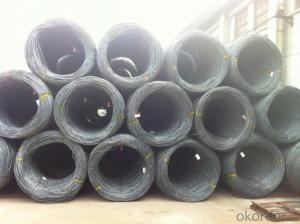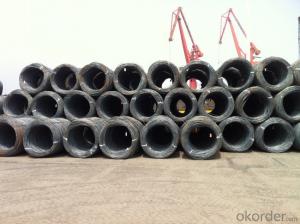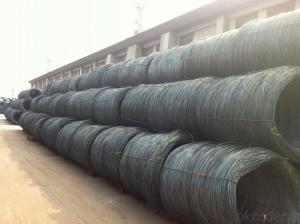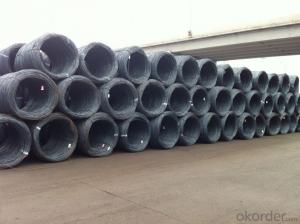Hot Rolled Wire Rods with SAE 1008 in Best Quality
- Loading Port:
- Tianjin
- Payment Terms:
- TT OR LC
- Min Order Qty:
- 25 m.t.
- Supply Capability:
- 10000 m.t./month
OKorder Service Pledge
OKorder Financial Service
You Might Also Like
Product Description:
OKorder is offering Carbon Steel Wire Rod at great prices with worldwide shipping. Our supplier is a world-class manufacturer of steel, with our products utilized the world over. OKorder annually supplies products to European, North American and Asian markets. We provide quotations within 24 hours of receiving an inquiry and guarantee competitive prices.
Product Applications:
Carbon Steel Wire Rod are ideal for structural applications and are widely used in the construction of buildings and bridges, and the manufacturing, petrochemical, and transportation industries.After hot-rolled the products shaped into coil and delivery as finished product, including round, square, rectangular, hexagonal and so on. Since most of the products are round, it is generally called wire rod. Carbon steel wire rod is widely used in construction and manufacturing. Carbon steel wire rod is mainly used for reinforcement of reinforced concrete and welded structure or reprocessed (roberts , nail, etc.) materials, especially used to produce wire drawing, welding electrode, nails, spring, electronic, precise machinery parts and so on.
Product Advantages:
OKorder's Carbon Steel Wire Rod are durable, strong, and resist corrosion.
Main Product Features:
· Premium quality
· Prompt delivery & seaworthy packing (30 days after receiving deposit)
· Corrosion resistance
· Can be recycled and reused
· Mill test certification
· Professional Service
· Competitive pricing
Product Specifications:
Chemical Composition:
Please kindly find our chemistry of our material based on SAE1006/SAE1008 as below for your information
Grade | Chemical Composition (%) | |||||
C | Mn | S | P | Si | B | |
SAE1006B | 0.03~O.07 | 0.32max | 0.045max | 0.040max | 0.30max | 0.0008min |
Mechanical properties | ||||||
Yield strength(N/mm2) | Tensile strength(N/mm2) | Elongation (%) | ||||
250-280 | 350-380 | ≥32 | ||||
Grade | Chemical Composition (%) | |||||
C | Mn | S | P | Si | B | |
SAE1008B | 0.10max | 0.3~0.50 | 0.050max | 0.040 max | 0.15max | 0.0008 min |
Mechanical properties | ||||||
Yield strength(N/mm2) | Tensile strength(N/mm2) | Elongation (%) | ||||
≥195 | 315-430 | ≥30 | ||||
FAQ:
Q1: Why buy Materials & Equipment from OKorder.com?
A1: All products offered by OKorder.com are carefully selected from China's most reliable manufacturing enterprises. Through its ISO certifications, OKorder.com adheres to the highest standards and a commitment to supply chain safety and customer satisfaction.
Q2: How do we guarantee the quality of our products?
A2: We have established an advanced quality management system which conducts strict quality tests at every step, from raw materials to the final product. At the same time, we provide extensive follow-up service assurances as required.
Q3: How soon we can delivery the goods ?
A3: We have a mill with 20000mts of capacity per month. We can delivery the goods within in one month ,as long as your order quantity less than 20000mts
Image

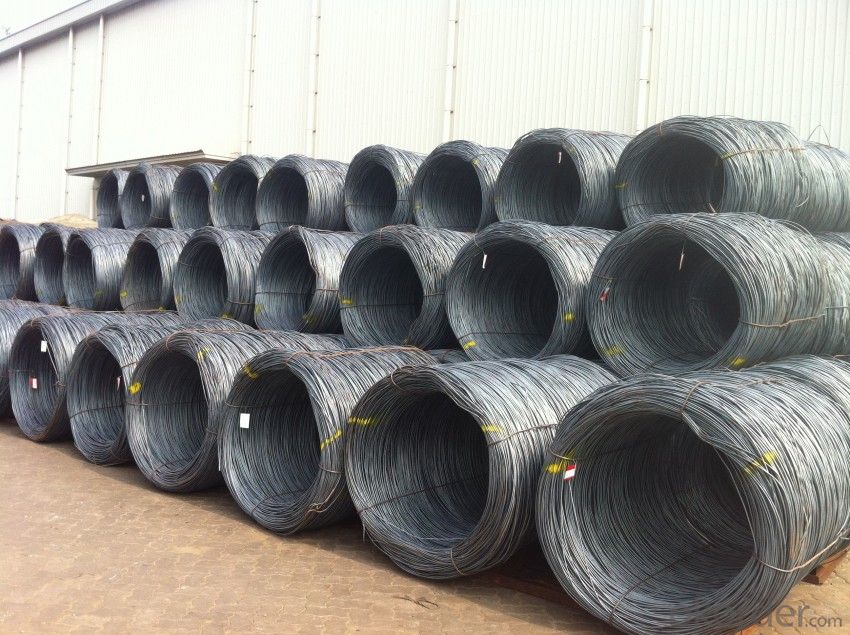
- Q:How is steel wire rod used in the telecommunications industry?
- Steel wire rod is used in the telecommunications industry primarily for the production of various types of cables, such as fiber optic cables and power cables. These cables are essential for transmitting data, voice, and power signals over long distances. Steel wire rod acts as a reinforcement component in these cables, providing strength and durability to support the transmission of signals effectively.
- Q:How is steel wire rod used in the production of wire for suspension bridge cables?
- The production of wire for suspension bridge cables heavily relies on steel wire rod, a crucial component. This wire rod is made from high-quality steel and is typically manufactured through the process of hot rolling. To create the wire for suspension bridge cables, the steel wire rod goes through various stages of processing. Initially, the wire rod is heated and then passed through a series of rollers, gradually reducing its size and shaping it into a continuous, long wire. This process is commonly referred to as wire drawing. The resulting wire then undergoes further processing to enhance its strength and durability. It is subjected to a heat treatment process, like annealing, which improves its mechanical properties. This treatment increases the wire's tensile strength, ensuring it can endure the immense loads and stresses experienced by suspension bridge cables. Once the wire has been appropriately treated, it is meticulously woven and braided to form the final suspension bridge cable. Multiple wires are twisted together to create strands, and several strands are then twisted together to form a larger cable. This intricate weaving process guarantees that the cable is strong, flexible, and corrosion-resistant. The use of steel wire rod in the production of suspension bridge cables is crucial because of its exceptional strength-to-weight ratio. Steel is renowned for its high tensile strength, making it ideal for supporting heavy loads over long distances. Moreover, steel wire rod offers excellent resistance to corrosion, ensuring the durability and structural integrity of suspension bridge cables. In conclusion, steel wire rod plays a vital role in producing wire for suspension bridge cables, providing the necessary strength, durability, and flexibility required for these critical infrastructure components. Its versatility and reliability make it the preferred material choice in constructing suspension bridge cables, guaranteeing the safety and functionality of these remarkable engineering marvels.
- Q:How is steel wire rod used in the manufacturing of wire forms for elevator shafts?
- Steel wire rod is an essential component in the manufacturing of wire forms for elevator shafts. Elevator shafts require strong and durable materials to ensure the safety and reliability of the elevator system. Steel wire rod, which is a long cylindrical steel product, is commonly used in this process due to its inherent strength and flexibility. Firstly, steel wire rod is used as the primary raw material for manufacturing wire forms for elevator shafts. The wire rod undergoes several processes, including drawing, annealing, and surface treatment, to enhance its mechanical properties and surface finish. These processes help to refine the steel wire rod and make it suitable for further manufacturing. Once the steel wire rod is prepared, it is formed into various wire shapes that are specifically designed for elevator shafts. These wire forms can include guide rails, safety ropes, suspension cables, and counterweight ropes, among others. Each wire form serves a crucial function in the elevator system, contributing to its smooth operation and ensuring the safety of passengers. The wire forms made from steel wire rod are known for their high tensile strength, which is essential for withstanding the heavy loads and constant movement experienced by elevator systems. The wires must be able to support the weight of the elevator car and its occupants while maintaining their structural integrity over time. Steel wire rod provides the necessary strength and durability to meet these requirements. Furthermore, steel wire rod offers excellent flexibility and elasticity, allowing the wire forms to withstand the dynamic movements of the elevator system. Elevators experience constant vertical and horizontal motions, as well as vibrations, which can put stress on the wire forms. Steel wire rod's flexibility helps to absorb and distribute these forces, reducing the risk of damage or failure. In addition to its mechanical properties, steel wire rod is also corrosion-resistant, providing long-lasting performance in elevator shafts. Elevator systems are often exposed to various environmental factors, such as humidity and temperature changes, which can cause corrosion and deterioration. By using steel wire rod, manufacturers can ensure that the wire forms will remain reliable and safe for an extended period. In conclusion, steel wire rod plays a vital role in the manufacturing of wire forms for elevator shafts. Its high tensile strength, flexibility, and corrosion resistance make it an ideal material for producing wire forms that can withstand the demanding conditions of elevator systems. By utilizing steel wire rod, manufacturers can create safe and durable wire forms that contribute to the smooth operation of elevators and the security of passengers.
- Q:How is steel wire rod used in the manufacturing of electrical wires?
- Steel wire rod is used in the manufacturing of electrical wires as the primary raw material. It is typically drawn through a series of dies to reduce its diameter and increase its length, resulting in a thin and flexible wire. This wire is then used to conduct electricity in various electrical applications, including power transmission, telecommunications, and electrical appliances.
- Q:What are the different surface inspection methods for steel wire rod?
- Steel wire rod can undergo a variety of surface inspection methods to ensure its quality and integrity. 1. The simplest and most basic method is visual inspection, where the surface is visually examined for visible defects like scratches, dents, or corrosion. 2. Another method is magnetic particle inspection, which involves applying a magnetic field and magnetic particles to the surface. Any defects or cracks cause the particles to cluster and become visible under UV light. 3. Eddy current testing is a non-destructive method that induces an electric current in the wire rod and measures the resulting electromagnetic field. Variations in the field can indicate surface defects. 4. Ultrasonic testing uses high-frequency sound waves to penetrate the surface. Defects or cracks reflect the sound waves, allowing for detection. 5. Dye penetrant inspection applies a liquid dye to the surface, which seeps into defects or cracks. After removing excess dye and applying a developer, the defects become visible. 6. Laser scanning is an advanced method that scans the surface using laser technology. It detects deviations from the normal surface profile and provides a detailed analysis. 7. X-ray inspection is used to inspect the internal and external surface of the wire rod. X-rays pass through the rod, and defects are detected by variations in the X-ray beam's intensity. Each method has its own advantages and limitations. The choice depends on specific requirements, the type of defects to be detected, and the desired level of accuracy.
- Q:What are the environmental impacts of producing steel wire rod?
- The production of steel wire rod can cause a range of environmental effects, both during the extraction of raw materials and the manufacturing process. Here are some of the main environmental consequences linked to producing steel wire rod: 1. Extraction of resources: Steel wire rod is mainly made from iron ore, which requires extensive mining activities. These mining operations can result in deforestation, destruction of habitats, and erosion of soil. Moreover, the extraction and transportation of iron ore contribute to the emission of greenhouse gases and air pollution. 2. Energy usage: The production of steel wire rod involves several energy-intensive processes, such as smelting, refining, and shaping. These processes typically rely on fossil fuels like coal and natural gas, which release substantial amounts of carbon dioxide into the atmosphere. High energy usage not only contributes to climate change but also depletes non-renewable resources. 3. Pollution of air and water: The manufacturing process for steel wire rod can release various pollutants into the air and water. During smelting, emissions of sulfur dioxide, nitrogen oxides, and particulate matter can contribute to air pollution and the occurrence of acid rain. Water pollution can arise from the discharge of wastewater containing heavy metals, oil, and chemicals used in the production process, potentially contaminating nearby water sources. 4. Generation of waste: The production of steel wire rod generates significant quantities of waste materials, including slag, dust, and sludge. These waste products often contain harmful substances such as heavy metals and toxic chemicals, which can pollute the environment if not properly managed. Waste disposal can also contribute to land degradation and the depletion of natural resources. 5. Emissions of carbon: Steel production, including the production of wire rod, is a major contributor to global carbon emissions. The high temperatures required to convert iron ore into steel result in the release of large amounts of carbon dioxide. Additionally, the use of fossil fuels in the manufacturing process further adds to the carbon footprint of steel wire rod production. To address these environmental impacts, the steel industry has been adopting various measures such as the implementation of cleaner technologies, improvement of energy efficiency, and reduction of reliance on fossil fuels. Additionally, recycling steel scrap can significantly reduce the environmental burden associated with steel wire rod production.
- Q:How are steel wire rods used in the manufacturing of springs?
- Steel wire rods are used in the manufacturing of springs by being shaped and coiled to create the desired spring shape and characteristics. The wire rods are typically formed into coils or helical shapes, which are then heat-treated and tempered to enhance their strength and flexibility. The resulting springs can be used in various applications, such as automotive suspensions, mechanical devices, and household appliances.
- Q:What are the different types of steel wire rod finishes for improved corrosion resistance?
- There are several types of steel wire rod finishes that can enhance corrosion resistance. Some common finishes include galvanized, zinc-coated, and stainless steel wire rods. These finishes provide a protective layer that prevents corrosion and rusting, making them suitable for various applications in industries such as construction, automotive, and marine.
- Q:What are the common packaging options for steel wire rod?
- The common packaging options for steel wire rod include coils, bundles, and wooden or steel pallets.
- Q:What are the common applications of cold heading quality steel wire rod?
- Cold heading quality steel wire rod is commonly used in the manufacturing industry for various applications such as producing bolts, screws, nuts, and other fasteners. It is also utilized in automotive parts, construction materials, and precision components where high strength and excellent cold forming characteristics are required.
1. Manufacturer Overview |
|
|---|---|
| Location | |
| Year Established | |
| Annual Output Value | |
| Main Markets | |
| Company Certifications | |
2. Manufacturer Certificates |
|
|---|---|
| a) Certification Name | |
| Range | |
| Reference | |
| Validity Period | |
3. Manufacturer Capability |
|
|---|---|
| a)Trade Capacity | |
| Nearest Port | |
| Export Percentage | |
| No.of Employees in Trade Department | |
| Language Spoken: | |
| b)Factory Information | |
| Factory Size: | |
| No. of Production Lines | |
| Contract Manufacturing | |
| Product Price Range | |
Send your message to us
Hot Rolled Wire Rods with SAE 1008 in Best Quality
- Loading Port:
- Tianjin
- Payment Terms:
- TT OR LC
- Min Order Qty:
- 25 m.t.
- Supply Capability:
- 10000 m.t./month
OKorder Service Pledge
OKorder Financial Service
Similar products
New products
Hot products
Hot Searches
Related keywords
